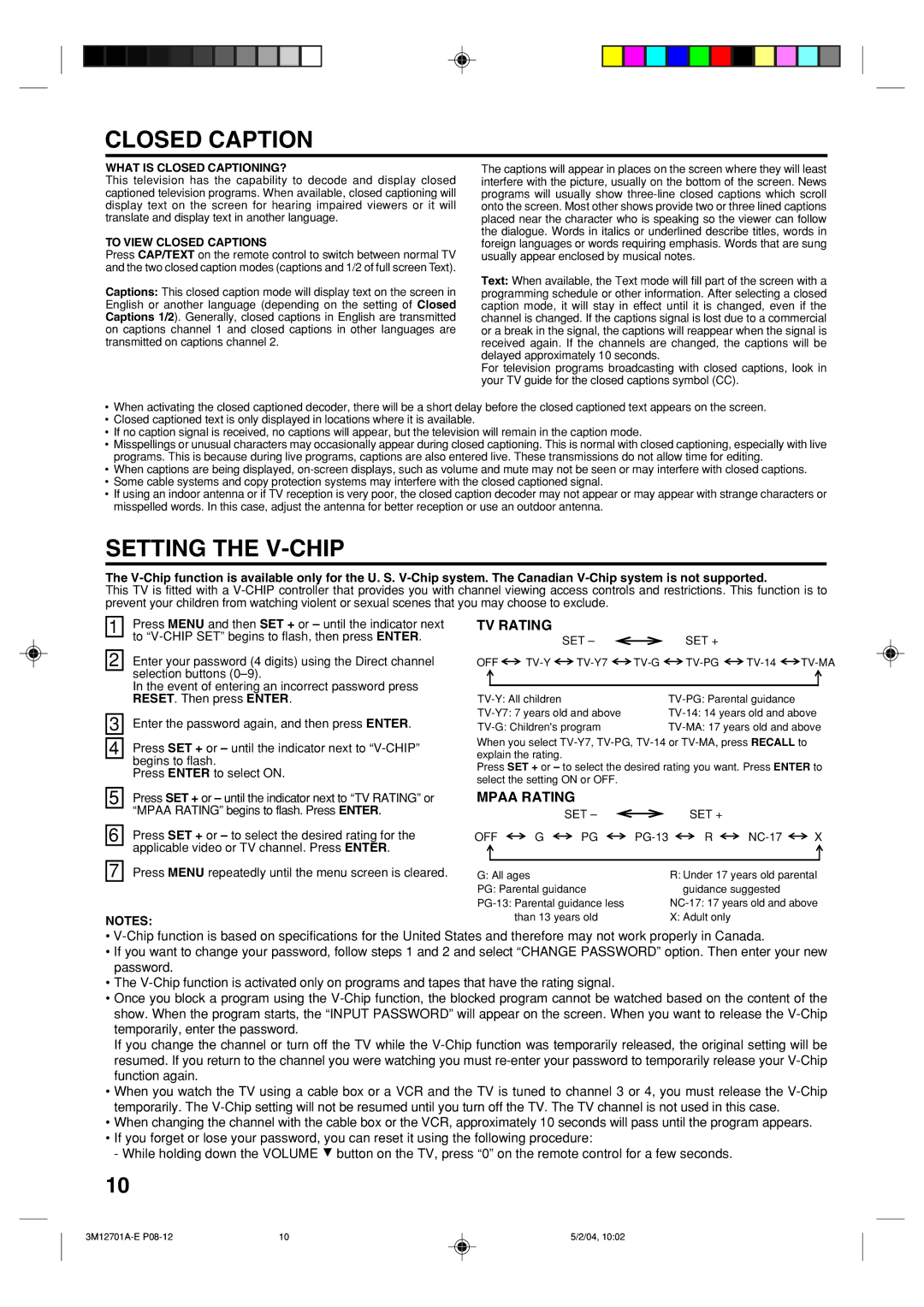
CLOSED CAPTION
WHAT IS CLOSED CAPTIONING?
This television has the capability to decode and display closed captioned television programs. When available, closed captioning will display text on the screen for hearing impaired viewers or it will translate and display text in another language.
TO VIEW CLOSED CAPTIONS
Press CAP/TEXT on the remote control to switch between normal TV and the two closed caption modes (captions and 1/2 of full screen Text).
Captions: This closed caption mode will display text on the screen in English or another language (depending on the setting of Closed Captions 1/2). Generally, closed captions in English are transmitted on captions channel 1 and closed captions in other languages are transmitted on captions channel 2.
The captions will appear in places on the screen where they will least interfere with the picture, usually on the bottom of the screen. News programs will usually show
Text: When available, the Text mode will fill part of the screen with a programming schedule or other information. After selecting a closed caption mode, it will stay in effect until it is changed, even if the channel is changed. If the captions signal is lost due to a commercial or a break in the signal, the captions will reappear when the signal is received again. If the channels are changed, the captions will be delayed approximately 10 seconds.
For television programs broadcasting with closed captions, look in your TV guide for the closed captions symbol (CC).
•When activating the closed captioned decoder, there will be a short delay before the closed captioned text appears on the screen.
•Closed captioned text is only displayed in locations where it is available.
•If no caption signal is received, no captions will appear, but the television will remain in the caption mode.
•Misspellings or unusual characters may occasionally appear during closed captioning. This is normal with closed captioning, especially with live programs. This is because during live programs, captions are also entered live. These transmissions do not allow time for editing.
•When captions are being displayed,
•Some cable systems and copy protection systems may interfere with the closed captioned signal.
•If using an indoor antenna or if TV reception is very poor, the closed caption decoder may not appear or may appear with strange characters or misspelled words. In this case, adjust the antenna for better reception or use an outdoor antenna.
SETTING THE V-CHIP
The
This TV is fitted with a
1 | Press MENU and then SET + or – until the indicator next |
| to |
| |
|
|
2 | Enter your password (4 digits) using the Direct channel |
| selection buttons |
| In the event of entering an incorrect password press |
| RESET. Then press ENTER. |
|
|
3 | Enter the password again, and then press ENTER. |
|
|
4 | Press SET + or – until the indicator next to |
| begins to flash. |
| Press ENTER to select ON. |
|
|
5 | Press SET + or – until the indicator next to “TV RATING” or |
| “MPAA RATING” begins to flash. Press ENTER. |
| |
|
|
6 | Press SET + or – to select the desired rating for the |
| applicable video or TV channel. Press ENTER. |
| |
|
|
7 | Press MENU repeatedly until the menu screen is cleared. |
NOTES:
TV RATING
SET – | SET + |
OFF ![]()
![]()
![]() TV-G
TV-G![]()
![]()
![]() TV-MA
TV-MA
When you select
Press SET + or – to select the desired rating you want. Press ENTER to select the setting ON or OFF.
MPAA RATING
SET – | SET + |
OFF  G
G  PG
PG 
PG-13  R
R 
NC-17  X
X
G: All ages | R: Under 17 years old parental |
PG: Parental guidance | guidance suggested |
than 13 years old | X: Adult only |
•
•If you want to change your password, follow steps 1 and 2 and select “CHANGE PASSWORD” option. Then enter your new password.
•The
•Once you block a program using the
If you change the channel or turn off the TV while the
•When you watch the TV using a cable box or a VCR and the TV is tuned to channel 3 or 4, you must release the
•When changing the channel with the cable box or the VCR, approximately 10 seconds will pass until the program appears.
•If you forget or lose your password, you can reset it using the following procedure:
- While holding down the VOLUME D button on the TV, press “0” on the remote control for a few seconds.
10
10 | 5/2/04, 10:02 |
